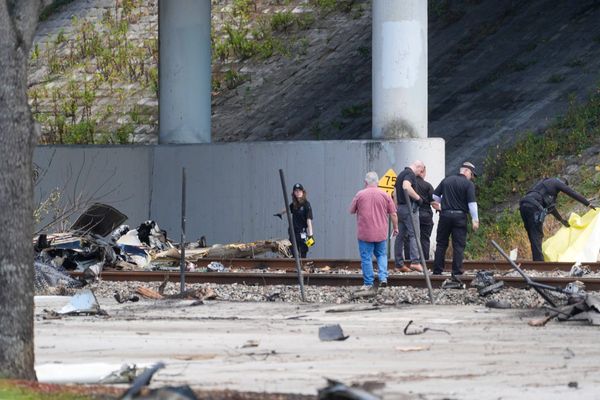
For much of its history Belfast has been the industrial dynamo of Ireland. During the 19th century it was Ireland’s largest city, and during the last half of the 19th century it was the fastest growing city in the British empire.
Belfast’s industrialization began with the mechanization off the flax industry. Flax had long been cultivated in Ireland and was the basis for the Irish linen trade. Starting in the early 19th century the process of processing flax fibers and spinning them became highly mechanized.
Belfast’s location on the Lagan River, with its extensive docks and port facilities, gave it ready access to a world market and rapidly transformed it into Ireland’s flax production center. At its peak, the industry employed some 65,000 workers, the bulk of them in the city.
Ship building and its associated industries, however, was the activity that would transform Belfast into Ireland’s industrial capital. In 1861, the ship building firm of Harland and Wolf was organized. The company quickly gained a reputation for building high quality ships.
Trans-Atlantic trade was booming during the late 19th century, which fueled a steady demand for ships. Ship building in turn drove a host of other industries from rope making to metal fabrication and machinery construction.
During this period the area known as Queen’s Island was steadily transformed into a vast shipbuilding complex spanning more than 80 acres and employing some 10,000 workers. By 1870, Harland and Wolf had forged a relationship with Thomas Ismay’s White Star Line. They would go on to build all but one of the White Star Line’s fleet of ships.

Harland and Wolf would go on to become the largest ship building firm in the world. It’s drydocks were also the world’s largest, allowing it to build the world’s biggest ships. In 1909, the firm began construction of the Olympic class passenger ships for the White State Line.
The ships, the largest ones hitherto ever conceived, would carry 3,500 passengers and crew. They would be 882 feet 9 inches long, enough to span three of the stormy Atlantic’s wave crests.
The first two ships, Olympic and Titanic were to be built simultaneously. Olympic was finished in 1911 and Titanic in 1912. The third, Britannic was completed in 1915. With a displacement of 45,000 tons the ships were roughly equivalent to a World War II era Iowa class battleship. The story of the Titanic’s ill-fated passage across the Atlantic is well known and has been the theme of countless books and films.
Harland and Wolf continued in the ship building business, eventually operating 5 ship building yards throughout Great Britain and employing over 65,000 workers. During World War II they constructed 130 warships for the Royal Navy. After the 1960s, however, the rise of air travel and competition from cheaper overseas yards led to a gradual decline in British ship building.
Queen’s Island, the area that had been the heart of Belfast’s ship building industry, declined in tandem and the former shipyards were abandoned.
In 2003, the city of Belfast in collaboration with the Belfast Harbour Commission launched an ambitious plan to redevelop the former ship building area on Queen’s Island into a tourist centered waterfront zone. Rechristened the Titanic Quarter, the new city district would be a mixed-use development along the Lagan River offering homes, retail outlets, hotels, offices, and entertainment and cultural amenities.
The center piece of that redevelopment is Titanic Belfast, a museum and interactive educational experience designed to chronicle both the industrial history of Belfast and its shipyards as well as the construction of Titanic and her sister ships and their subsequent fate. Here’s a link for more information on Titanic Belfast.

The museum rests on what was once Harlan and Wolf’s plating works. Behind it stretch the drydocks in which Titanic and Olympic were built. They are now filled in and covered with grass, although the dimensions of the hulls are outlined in a continuous strip of blue lit glass.
The right-hand side, as you face down the Lagan towards the sea, where the Titanic was built, consists of a series of four lawns divided by timber decks. It is a memorial to the Titanic’s victims.
The four sets of lawns and timber deck commemorate the three classes of passage on the Titanic as well as the crew. The proportion of lawn to timber decks reflects the ratio of deceased (lawn) to survivors (timber deck). The fourth lawn, the one closest to the river has the smallest timber deck. It commemorates the crew. Less than a quarter survived.
The names of the victims are set in glass panels alongside. Benches corresponding to the actual position of benches on the ships are located on the flanks of the former drydocks. Most of the deceased where buried at sea. The balance was interred at Fairview Cemetery in Halifax, Nova Scotia. Most of the bodies were never recovered.
Across the street from Titanic Belfast are the former offices of Harlan and Wolf. Today the building houses the Titanic Hotel. True to its name, the hotel is full of memorabilia from Titanic and its sister ships, as well as artifacts from the White Star Line and from Harlan and Wolf. The central atrium that once housed the firm’s legion of naval architects and draftsmen now hosts the hotel bar and common area.


The Titanic sign in front of the museum is cut from the same 1-inch thick steel plate that was used to construct the ship. The building itself is designed to resemble the bows of four ships radiating in opposite directions.
The four bows represent the four eras of ship building in Belfast: wood, iron steel and aluminum. The bows have the same dimensions as those of Titanic and her sister ships. The design also reflects the shape of a water crystal—a symbolic representation of the ice that was Titanic’s demise.
The Titanic quarter is only a short walk from the center of Belfast. The cruise ship dock where modern cruise ships tie up when they stop in Belfast is a little further down the Lagan, on the opposite waterfront, and is about a 10-minute taxi ride away.
You can see Titanic Belfast and the location of the former drydocks from the decks of the cruise ships. Arriving there is about a 45-minute walk or a short, convoluted taxi ride.
A hundred years after the Titanic disaster, Belfast has finally embraced its Titanic heritage; using the history of the ill-fated ship to tell the story not only of the engineering marvel that Titanic represented but also the history of Belfast and how its shipyards were once the mightiest in the world.
If you ever find yourself in Belfast, especially if you are on a cruise ship that stops there for the day, Titanic Belfast is definitely worth a stop. While you’re there go across the street to the bar at the Titanic Hotel. You can enjoy a drink in the same room where Titanic and her sister ships were designed.







